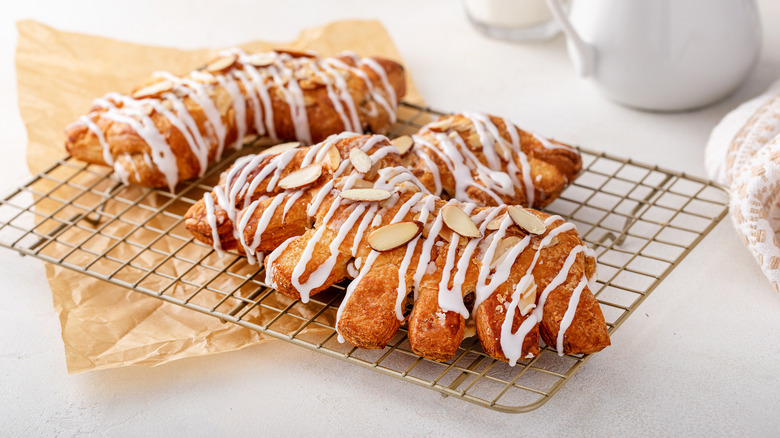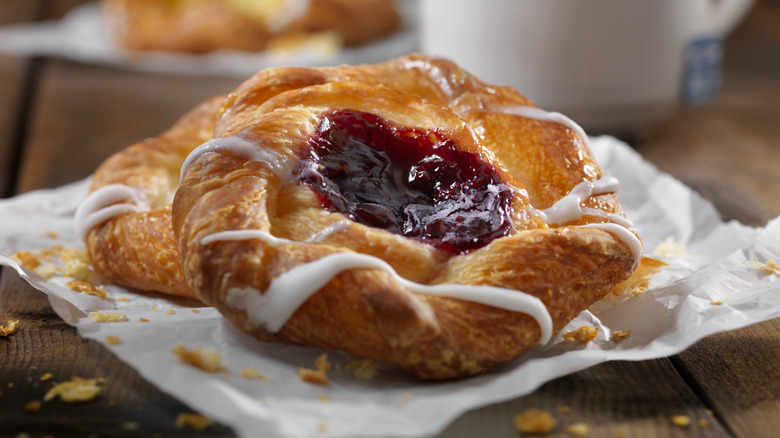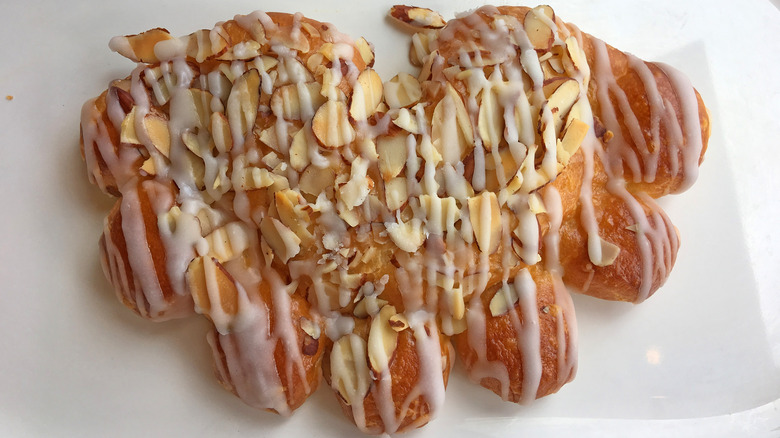The Intriguing Origins Of Bear Claw Pastries
Bear claws are the quintessential breakfast buffet pastry. If there's a hotel in the United States that doesn't serve them, we've yet to find it. It's easy to see why bear claws hold such appeal to the grab-and-go breakfaster, packing rich, sweet flavors into a portable yeast-raised puff pastry shell. The fact that it's shaped like an adorable paw only makes it better. Though traditionally stuffed with almond paste accompanied by a sprinkling of almond slices on top, bear claws work with just about any sweet filling you can think of, including fruit, jam, nuts, and cream cheese.
According to a decades-old survey of regional American dialects, the use of the term "bear claw" to specifically describe a type of pastry is more common west of the Mississippi (per The Atlantic). It is particularly prominent in California, which makes sense, as the Golden State is widely believed to be the origin point of bear claw pastries.
American bear claws are related to pastries from Denmark known as kamme, meaning "combs," and they first appeared in California in the early 20th century. A bakery menu printed in the Sacramento Star on March 13, 1914, lists bear claws being sold for five cents by a German bakery — cleverly named "The German Bakery" — owned by J.L. Geibel. By the next year, bear claws were on the breakfast menu at Hamburger's Los Angeles, which was then the largest department store west of Chicago.
The curious nature of Danish pastries
Bear claws are considered a type of Danish pastry, which is characterized by having a flaky, leavened dough paired with a variety of sweet fillings and toppings. It would be natural to assume that Danish pastries originated in Denmark, but this isn't really the case. Their roots can be traced to the invention of puff pastry in France in the early 1600s, the technique soon spreading to other European nations. Even so, the Danish connection wouldn't be made until much later.
One of the prevailing theories is that in 1850, Danish bakers went on strike, protesting the fact that they weren't actually being paid, just given food and a place to live. In response, their employers began hiring bakers from other countries, many of whom came from Austria. Those Austrian bakers introduced the puff pastry technique to Denmark. Today, the term "Danish pastry" is widely used everywhere but Denmark — where Danes themselves still call it wienerbrød, meaning "Viennese bread."
So, why do the Danes get credit for this type of pastry if it didn't really originate in Denmark? You can chalk that up to the substantial emigration of Danish bakers to other countries, especially the United States (particularly California — there's even a traditional Danish village called Solvang), where bear claws and other types of Danish are popular at any time of day.
The trick that makes bear claws so flaky
The key to bear claws lies in a technique called lamination, which involves rolling and folding the dough into a series of thin layers. There is cold butter sandwiched between each layer that melts into the dough as it bakes, creating a rich flavor and flaky texture. Laminated doughs are also used to make croissants, tuiles, and other types of Danishes.
The origins of the puff pastry on which Danishes are based are even murkier than that of the bear claw. A popular theory says that it was invented in 1600s France by a baker's apprentice named Claudius Gelee, who forgot to add butter to his dough until the very last minute, and folded cold bits of it in. However, there is little to support this story, and it likely comes from a myth surrounding the famous Baroque painter Claude Lorrain (who was also known as Claude Gellee or Gelee and briefly served as a baker's apprentice).
In addition to bear claws — aka kamme, there are a few other popular varieties of Danish pastry you should know. The most widely known is the spandauer, which is the classic circular Danish with a dollop of custard or jam in the center. Another popular variety is the kanelsnegle, the Danish take on a swirled cinnamon roll, whose name means "cinnamon snail." If you like that, consider the chocolate version of a kanelsnegl, known as a direktørsnegl ("boss snail").


